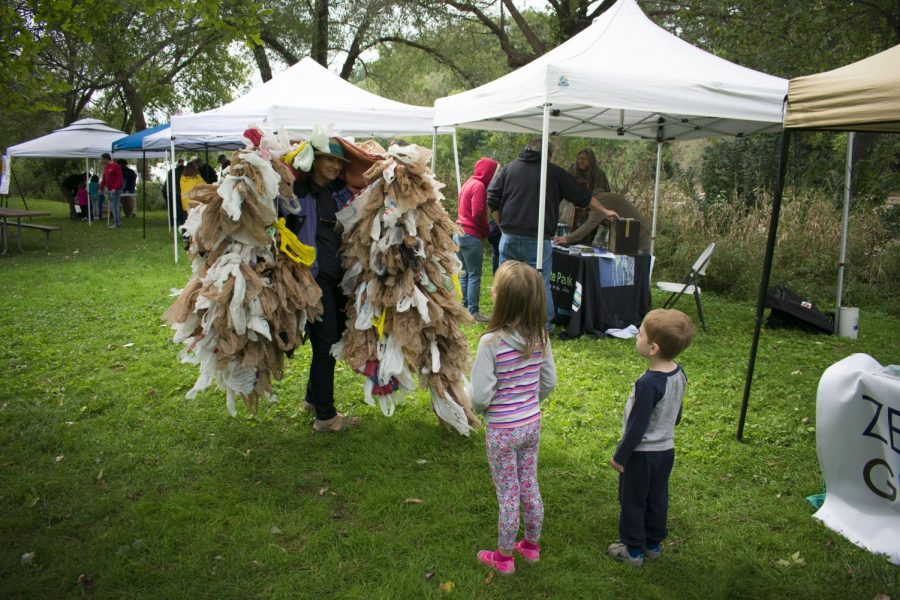Local festival promotes eco-friendly MKE
Two kids listen to Sue Anderson as she explains about plastic waste. Anderson wore the costume to promote Plastic Free MKE at the Fish and Feather Festival.
Community members attending the fifth annual Fish and Feather Festival at Hubbard Park had the chance to learn about environmental conservation efforts and solutions, participate in hands-on activities and enjoy nature.
“[The festival’s purpose] is really to get people out to connect them to the river and our parks,” said Kae DonLevy, Festival and Shorewood Waters Project coordinator.
Visitors participated in lessons in fly fishing, painted pumpkins and birdhouses and built bee habitats from biodegradable materials while listening to live music. They also had the opportunity to interact with chickens, turtles and other animals.
The Village of Shorewood, the Shorewood Waters Project and the Shorewood Conservation Committee hosted the event, which brought together representatives from a wide variety of organizations and companies to host booths, informing visitors about many different environmental topics.
Children visiting DonLevy’s Shorewood Waters Project booth answered questions about water resources to spin the Water Wheel and win small prizes, while parents learned about the Project’s Shorewood Loves Dogs Campaign.
“We have a new [dog] mascot, which is Mika,” DonLevy said. “She’s helping us educate the community about dog waste and how to manage it. There are 89 million dogs in the US, and if they all [poop] a pound and a half a day, that’s 40 billion pounds every year that dogs generate. So, if we don’t pick it up, it goes right into our waterways, and that’s where the majority of people get their water for drinking,”
The Milwaukee Riverkeeper booth also taught people about conserving aquatic resources.
“[The goal is] to educate,” said Jacob Rogers, Milwaukee Riverkeeper representative. “I think one of the more important things that we see [is that] the community is sometimes not educated about the water systems here, and just how fragile they are. So, our organization, we help to protect, restore, advocate, and then connect with people in our communities to have them better understand the three rivers in Milwaukee.”
Sue Anderson, Plastic Free MKE representative, wore a cloak covered with 500 plastic bags to make a statement about single-use plastic.
“I am the plastic bag monster today,” Anderson said. “Plastic Free MKE is trying to get people to eliminate single-use plastic: the plastic you use once and throw away. Plastic water bottles, plastic forks, plastic straws, plastic bags. So this [costume] is to get people to look at it and say, ‘Wow, why does she have so many bags?’”
According to Anderson, the average person throws away 500 plastic bags a year.
“So [with plastic] bags people think, ‘Oh, well I took them back to the store and they’re recycling them,’” Anderson said. “They’re going in the trash somewhere. And then a lot of the plastic trash ends up in the river, in the lake, and lake Michigan has the most plastic of any of the Great Lakes, so a lot of it’s happening right here in Milwaukee. A lot of that plastic is right here in Milwaukee.”
To combat this issue, Plastic Free MKE is working with restaurants and grocery stores to eliminate their single-use plastic and teaching community members about alternatives.
“I wish there were more people here [at the Festival], but I think we’re getting great questions, and obviously the plastic bag [costume] attracts attention so people come up and start asking questions, which is the whole point: for people to start thinking,” Anderson said.
Carrie Bristoll-Groll, CEO of Stormwater Solutions Engineering, LLC, showcased the product she designed, StormGUARDen. StormGUARDen, a combination between a rain barrel and a rain garden, uses plants to manage the water that comes off of the user’s roof.
“It filters [the water], and it acts sort of like a wetland on top and a cistern on the bottom,” Bristoll-Groll said. “So it allows water to be filtered and cleaned, and also you can store it to use it elsewhere in your yard, or you can let it drain away, so that it just temporarily holds the water, and keeps it from sort of flooding your neighbors, or ponding in your yard.”
According to Bristoll-Groll, the StormGUARDen has benefits beyond the backyard.
“The more that we can try to sustainably hold that water where it falls, the less amount of pollution the water is going to be carrying down to the river quickly through sewers, and also the less amount of flooding that will happen, like in the city roadways, because we’re managing in all these little places, in green infrastructure,” Bristoll-Groll said.
The Shorewood Conservation Committee dealt with yards and how to make them more sustainable.
“We’re promoting this new survey that asks Shorewood residents how they’re using their yards and what barriers they face in [bettering] their yards, whether it’s keeping control of weeds, or bringing more wildlife into their yards. We’re encouraging people to take this survey which will help us educate the community on how they can achieve more in their yards, maybe [have] less reliance on pesticides and fertilizers,” said Josh Liveratore, Committee chair.
DonLevy thinks that it is important to get people outside to experience their natural resources, including the river.
“People think the Milwaukee River is still really dirty and gross, but we have worked so hard the last 25 years cleaning it up, and it’s in really good shape,” DonLevy said. “It’s a beautiful place to canoe and kayak, there’s a lot of fly fishing that goes on on this river, by Hubbard Park, and they even had a swim contest closer to downtown, in the river, because it is getting so clean. So, we’re very excited about all the achievements we’ve made cleaning it up, but we can’t go backwards. We have to let people know they still have to protect it, keep it so it’s a resource we can use.”

